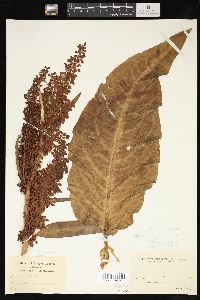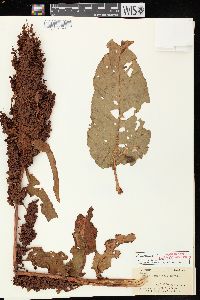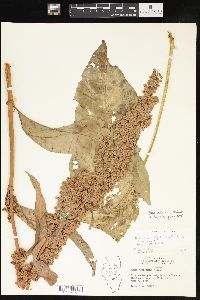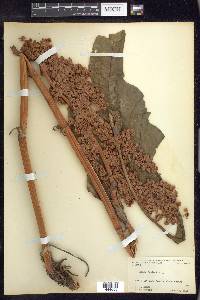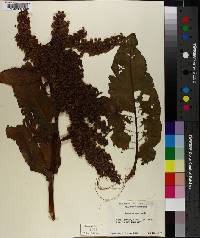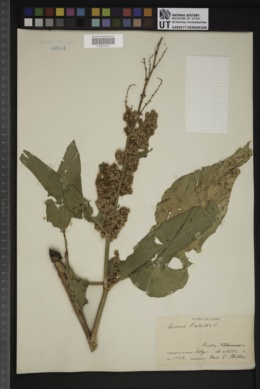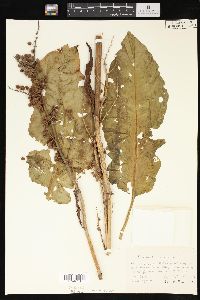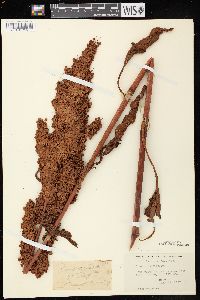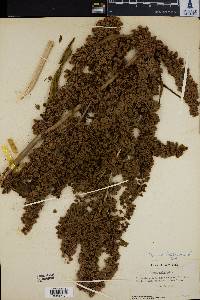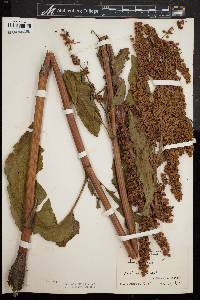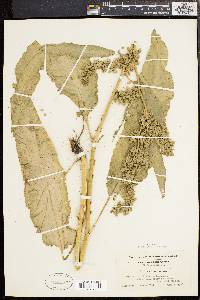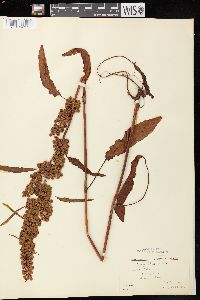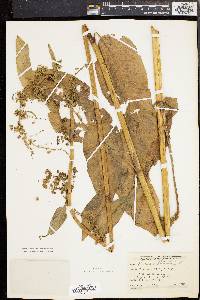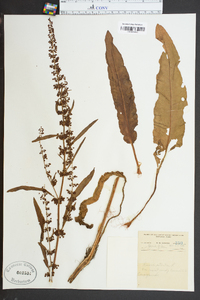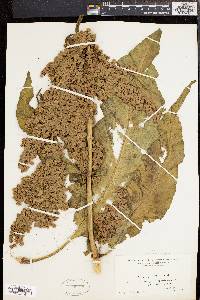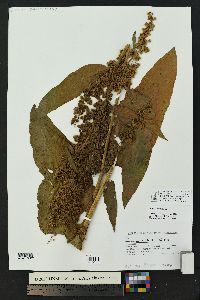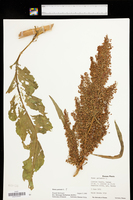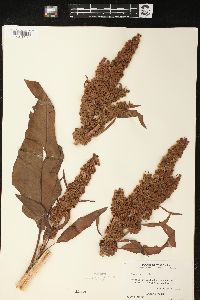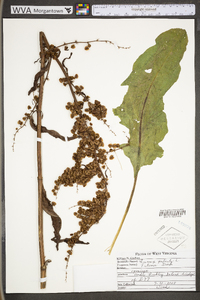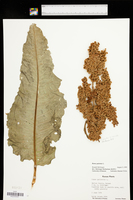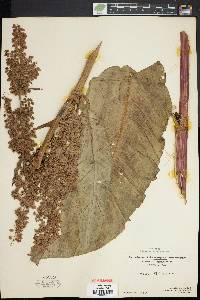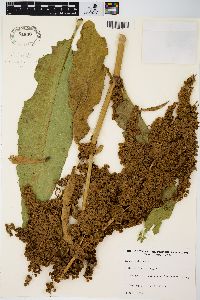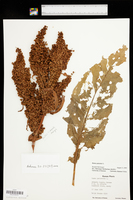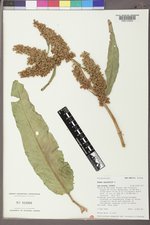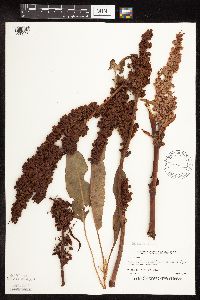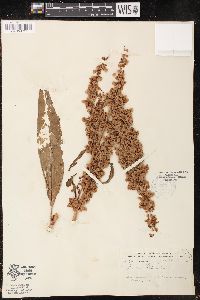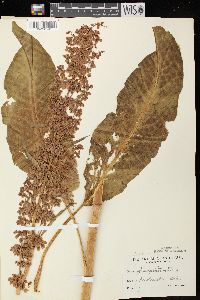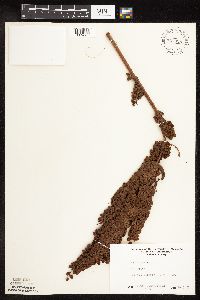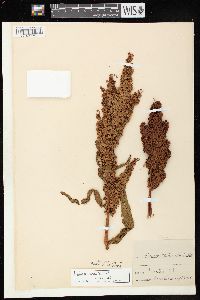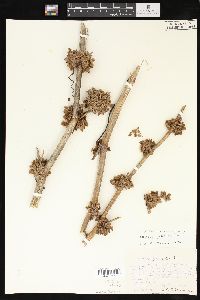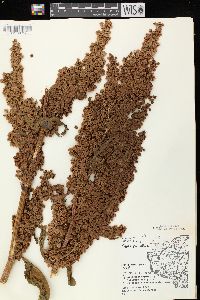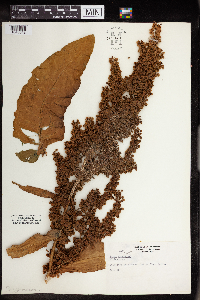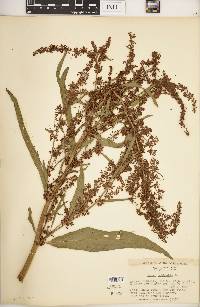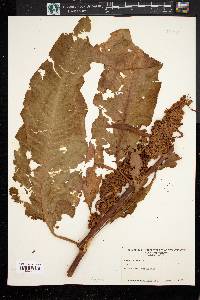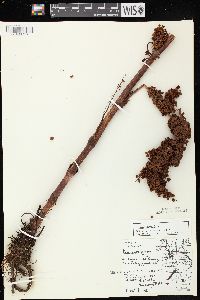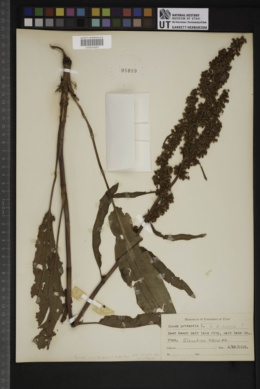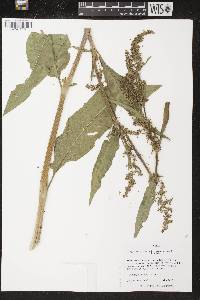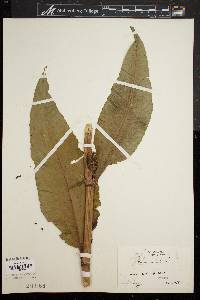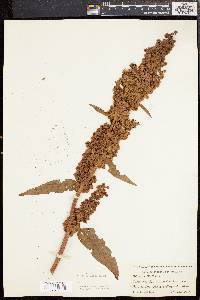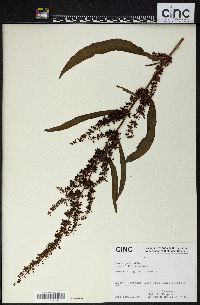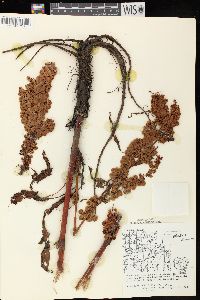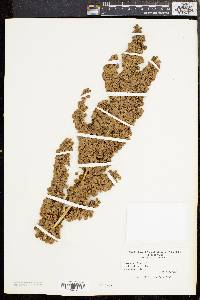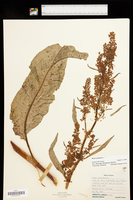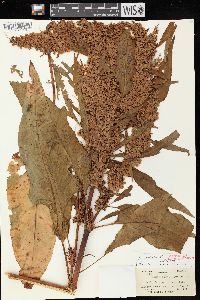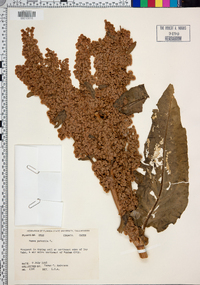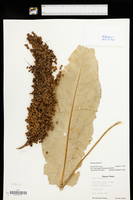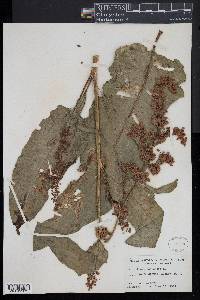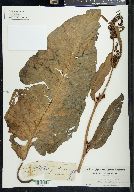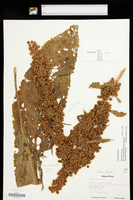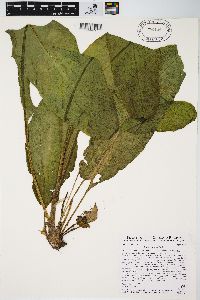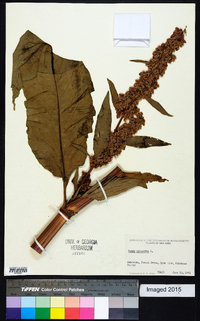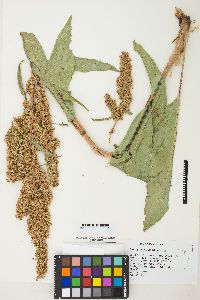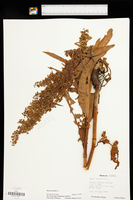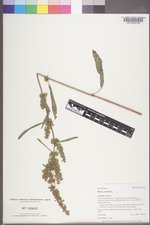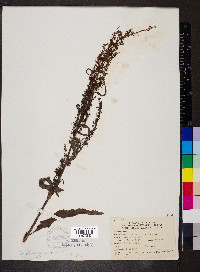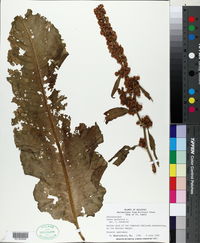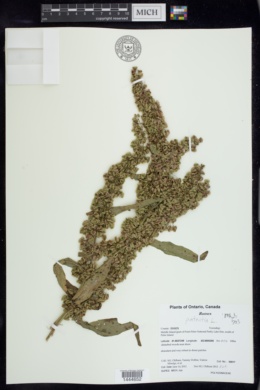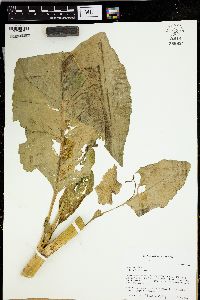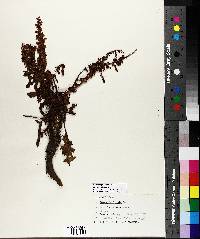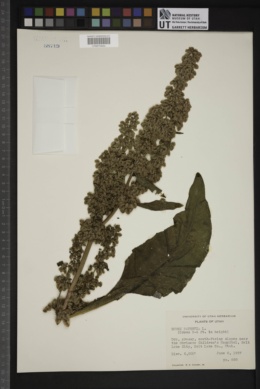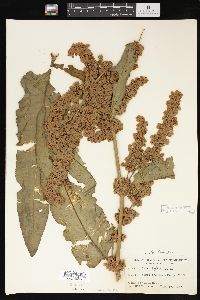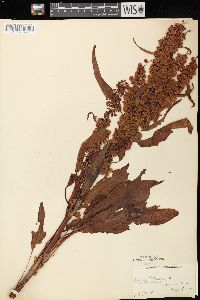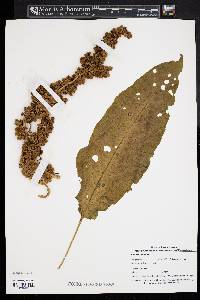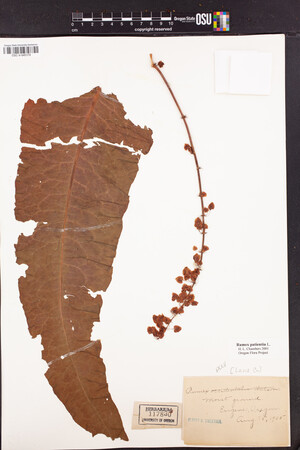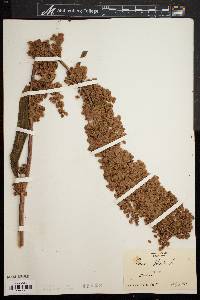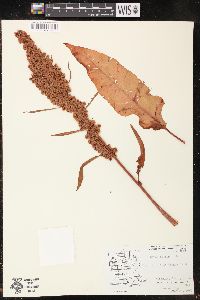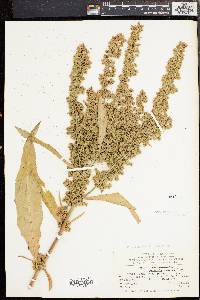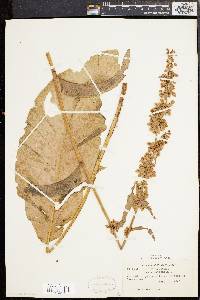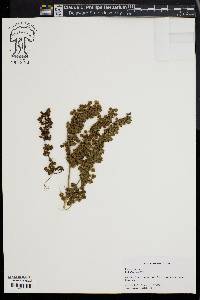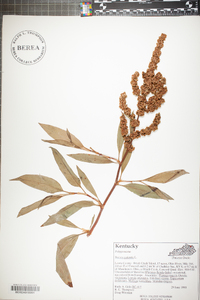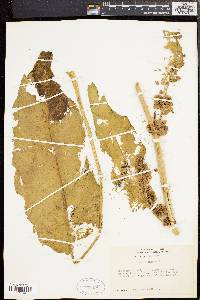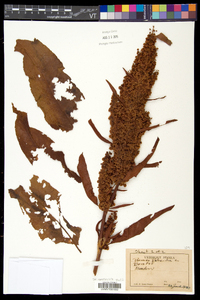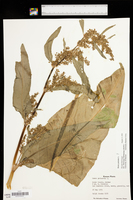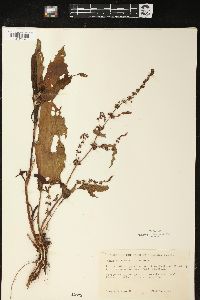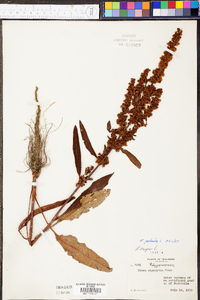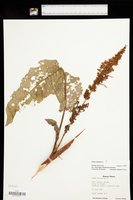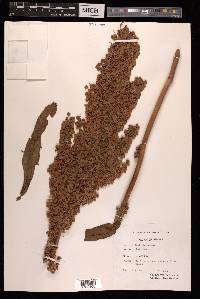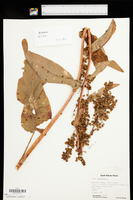Rumex patientia
|
|
|
|
Family: Polygonaceae
Patience Dock
|
Plants perennial, glabrous or very indistinctly papillose normally only on veins of leaf blades abaxially, with fusiform, vertical rootstock. Stems erect, branched from above middle, 80-150(-200) cm. Leaves: ocrea deciduous or partially persistent at maturity; blade ovate-lanceolate or oblong-lanceolate, normally 30-45(-50) × 10-15 cm, base truncate, broadly cuneate, or weakly cordate, margins entire, flat or weakly undulate, apex acute or subacute. Inflorescences terminal, occupying distal 1/ 2 of stem, normally dense, narrowly to broadly paniculate, branches usually straight or arcuate, rarely indistinctly flexuous. Pedicels articulated in proximal 1/3, sometimes almost near base, filiform, 5-13(-17) mm, articulation usually distinctly swollen. Flowers 10-20(-25) in whorls; inner tepals broadly ovate, suborbiculate, or orbiculate, (5-)5.5-8(-10) × 5-9(-10) mm, base usually distinctly cordate, margins entire or subentire to very weakly erose, apex obtuse or occasionally subacute; tubercles normally 1, more than 1 mm wide, normally less than 2 times as wide as inner tepals, occasionally 3, then 2 much smaller. Achenes brown, 3-3.5 × 1.5-2.5 mm. 2n = 60. Flowering late spring-summer. Waste places, roadsides, old fields, gardens, disturbed meadows, occasionally in alluvial habitats; 0-2300 m; introduced; Ont., Que.; Conn., Idaho, Ill., Ind., Iowa, Kans., Ky., Maine, Md., Mass., Mich., Minn., Mo., Mont., Nebr., N.H., N.J., N.Y., N.C., N.Dak., Ohio, Okla., Pa., R.I., S.Dak., Tenn., Utah, Vt., Va., Wash., W.Va., Wis., Wyo.; e, s Europe; w Asia; introduced elsewhere. Some North American specimens of Rumex patientia appear to belong to subsp. orientalis (= R. orientalis Bernhardi 1830, not Campderá 1819; R. lonaczevskii), which differs from subsp. patientia in having larger inner tepals (6-10 × 8-10 mm, not 4-8 × 4-8 mm). A predominantly Asian variety with three tubercles sometimes is recognized as subsp. callosus (Fr. Schmidt ex Maximowicz) Rechinger f. [= var. callosus Fr. Schmidt ex Maximowicz; Rumex callosus (Fr. Schmidt ex Maximowicz) Rechinger f.]. However, the distribution of infraspecific taxa of R. patientia in North America has not been studied in detail. Rumex patientia may be expected in southern Canada, especially the prairie regions of Alberta, Manitoba, and Saskatchewan, as well as in Colorado and other states. According to J. T. Kartesz (1987, vol. 1), a record from Nevada was based on misidentification of R. crispus. Rumex patientia is the lectotype of the genus. It and the following two species belong to subsect. Rumex.
Stout, taprooted, glabrous perennial to 2 m, simple to the infl; lvs pale green, basally disposed, somewhat crisped, oblong to oblanceolate, to 15 cm wide, the larger (lower) truncate to subcordate at base, the smaller acute; lateral veins of the lvs making an angle of 45-60ڠwith the midrib; infl to 5 dm, with stout, ascending branches subtended by reduced lvs, otherwise leafless, the verticils eventually contiguous; pedicels 5-10 mm, visibly jointed near the base; valves broadly rounded, 6-9 mm, very blunt, deeply cordate, subentire to crenate-undulate; grain 1, to a third as long as the valve; 2n=60. Native of Europe, occasionally found in waste places in our range. Hybridizes with nos. 11 [Rumex crispus L.] and 16 [Rumex obtusifolius L.].
Two other closely related ruderal European spp., rarely adventive with us, have small grains, as in R. patientia, but on all 3 valves, and the valves are usually ±toothed; the lateral veins of the lvs make an angle of 60-90ڠwith the midrib. R. cristatus DC. has red-brown valves with numerous irregular teeth ca 1 mm, and the lvs are smooth beneath. R. kerneri BorbⳠhas dark brown valves with smaller, sometimes indistinct teeth, and the lvs are minutely papillose-scabrid beneath. Gleason, Henry A. & Cronquist, Arthur J. 1991. Manual of vascular plants of northeastern United States and adjacent Canada. lxxv + 910 pp. ©The New York Botanical Garden. All rights reserved. Used by permission. From Flora of Indiana (1940) by Charles C. Deam Indiana Coefficient of Conservatism: C = null, non-native Wetland Indicator Status: N/A |

